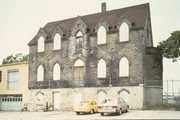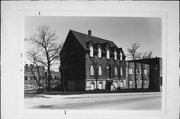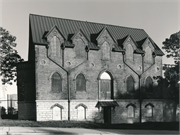Property Record
325 W COURT ST
Architecture and History Inventory
| Historic Name: | Saint John de Nepomuc Rectory |
|---|---|
| Other Name: | Bohemian Church |
| Contributing: | |
| Reference Number: | 63217 |
| Location (Address): | 325 W COURT ST |
|---|---|
| County: | Milwaukee |
| City: | Milwaukee |
| Township/Village: | |
| Unincorporated Community: | |
| Town: | |
| Range: | |
| Direction: | |
| Section: | |
| Quarter Section: | |
| Quarter/Quarter Section: |
| Year Built: | 1859 |
|---|---|
| Additions: | 1907 1867 |
| Survey Date: | 20041982 |
| Historic Use: | rectory/parsonage |
| Architectural Style: | Early Gothic Revival |
| Structural System: | |
| Wall Material: | Cream Brick |
| Architect: | |
| Other Buildings On Site: | |
| Demolished?: | No |
| Demolished Date: |
| National/State Register Listing Name: | Saint John de Nepomuc Rectory |
|---|---|
| National Register Multiple Property Name: | Multiple Resources of N. 3rd St. - Brewers' Hill |
| Additional Information: | ARCHITECTURAL STATEMENT: The St. John de Nepomuc Society rectory is a Gothic Revival style building of singular design. It is a three-story masonry stucture with the lower level partially below grade. The lower level is coursed limestone, while the upper floors are brick. The plan is rectangular with a projecting bay on the north end elevation. The longer west front elevation parallels North Fourth Street. It is this elevation which incorporates the rather unique group of pointed arch openings which give the buiding its distinctive character. The facade is a symmetrical arrangement which is punctuated by five openings on each level. The center one on each floor is treated differently - in the basement and first floor it is a door opening, while at the second floor it is a dormer which is taller that the others. Together, the five closely spaced dormers give the Rectory a picturesque Gothic appearance. A band of small, round inset circles extends around the building between the first and second floor levels as well as above the dormer windows. The north elevation features decorative masonry work above the dormer windows. The north elevation features decorative masonry work in the form of a stepped design along each gable and a circular medallion with a Greek cross in it. The primary entry originally was the more embellished first floor opening. It features a pair of doors with Gothic arch panels and transom above. Originally a pair of curved stairs rose to each side of this door. Presently, all window openings are blocked closed with brick and wood. Even with these changes the building has retained its form and general design features, comparing favorably with historical lithographs. None of the original remains. (MI 58/29). The Rectory is all that remains of an entire complex that occupied a half block bounded by Fourth, Court, Cherry and Third Streets. On the site were a school, Rectory and Church. The church faced south onto Cherry Street, the Rectory faced west onto Fourth Street and the school was oriented north to Court Street. The school has been demolished as well as the Church. The Church had undergone several remodelings in this century. When a new denomination took over in 1963 the first floor was lowereed and the entrance completely remodeled. In 1944, the first floor was used for commercial storage. A second floor was added in 1949 for the same purpose. Demolition occurred in 1956. Since then, a manufacturing concern has been built on the site. An addition to the rear of this now joins the Rectory to the factory. This addition does not contribute to the significance of the nominated property. SIGNIFICANCE: The St. John de Nepomuc Society Rectory is an uncommon example of the Gothic Revival style in Milwaukee. It is a well executed design incorporating several Gothic elements making it architecturally significant. The symmetrical west facade with five gables and multiple Gothic arch openings is an excellent design. The Rectory of the St. John de Nepomuc Society is an uncommon early example of the Gothic Revival in Brewers' Hill and the City as a whole. The numerous examples of Gothic Revival churches which remain today date generally from the 1870s or 1880s. Only the North Prsbyterian Church (now the MSOE Bookstore) at 1001 North Milwaukee Street predates the Rectory, having been built 1854-1855. The drip moldings, the rondels between the stories, the stone foundation and the decorative brickwork in the gable make it a particularly rich example in comparison to the North Presbyterian Church. HISTORICAL STATEMENT: The St. John de Nepomuc Society Rectory is historically significant for its association with the early Czechoslovakian settlement in Milwaukee. The Austrian Revolution of 1848 spurred emigration to this country. Population tended to disperse across the eastern half and western edge of Wisconsin through the 1860s and 1870s. Bohemian activity was reported in the press from Watertown, Trempleau, and Racine among other places. By 1890 Kewaunee's population was three-sevenths Bohemians. A number of Milwaukee Bohemians arrived in 1860 per "Senteniel" reports. In that year, Catholic Czechs formed a society to raise money to annually bring a priest who could hear confessions in their native language. In 1866 the Benevolent Society of St. John de Nepomuc was incorporated. A bill was introduced into the assembly for this purpose and passage enabled the group to establish a parish. St. Johannes was organized by the Reverend Martin Kundig, who was the first priest and Vicar-General. The church building was constructed in 1867. Reverend Kundig was succeeded by Reverend John Gardner who was pastor until 1875. Reverend Leo J. Suchy followed, and was responsible for building a new school. Reverend Suchy was chaplain of the Bohemian Catholic Society for Benevolent Purposes in the United States, and also Apostolic Missionary to the U.S. from the Franciscan order, being the only Bohemian priest in the Diocese. Reverend Suchy was also instrumental in establishing a second Bohemian parish on Milwaukee's south side. In 1883 he became pastor of the new parish, St. Wenceslaus. Connected with St. John de Nepomuc were several benevolent societies comprised of parish members including St. Johannes von Nepomuc, St. Joseph's Men's Society, St. Wenceslaus, Young Ladies Soceity, St. Alois and so on. These were organizations similar to any parish (such as St. Francis) which functioned to promote devotion, pracitce of charitable deeds and so on. The parish also organized the National Building and Loan Association to meet the parishioners secular needs. These organizations served to create a community within the larger urban context. Health care, recreation, spiritual and economic necessities were all met through association with a parish. The St. John de Nepomuc Rectory thus represents the only surviving trace of the Bohemian settlement in the Brewers' Hill area. It also represents the first Catholic parish in the area, preceding the St. Francis Monastery by two years and St. Francis Parish by three years. The Rectory was used by the St. John de Nepomuc parish until 1907. Various other congregations utilized the building over the years including the First Hungarian Reformed Church in 1928-1935; the First Pentecostal Assembly of the World in 1939-1940; the David Spiritual Temple of Christ in 1942 and the Church of the Living God in 1944-1945. Period of significance: 1867-1907. Previously surveyed in 1982 with a map code of 58/29 on a Historic Brewer's Hill-1982 map. Previously listed as the SE corner of Court and 4th Streets. |
|---|---|
| Bibliographic References: | Past in our Present. A. 1876 Rascher Atlas. B. History of Milwaukee, Wisconsin, 1881. C. Built in Milwaukee, Garber, 1980. D. Still, Bayrd, "Milwaukee: The History of a City." Madison: The State Historical Society of Wisconsin, 1948. E. Insurance Maps of Milwaukee, Sanborn-Perris, 1910. F. Milwaukee "Sentinel," January 3, 1890. G. "The Catholic Church in Wisconsin." Catholic Historical Publishing Co., 1897. |
| Wisconsin Architecture and History Inventory, State Historic Preservation Office, Wisconsin Historical Society, Madison, Wisconsin |



